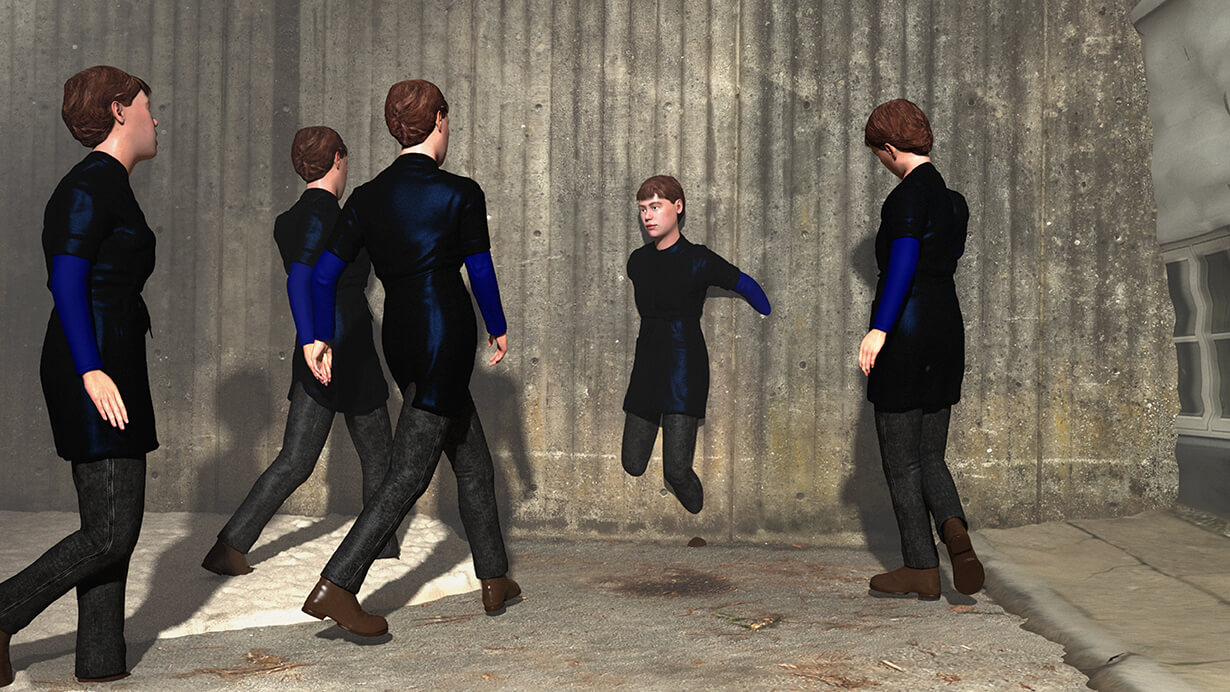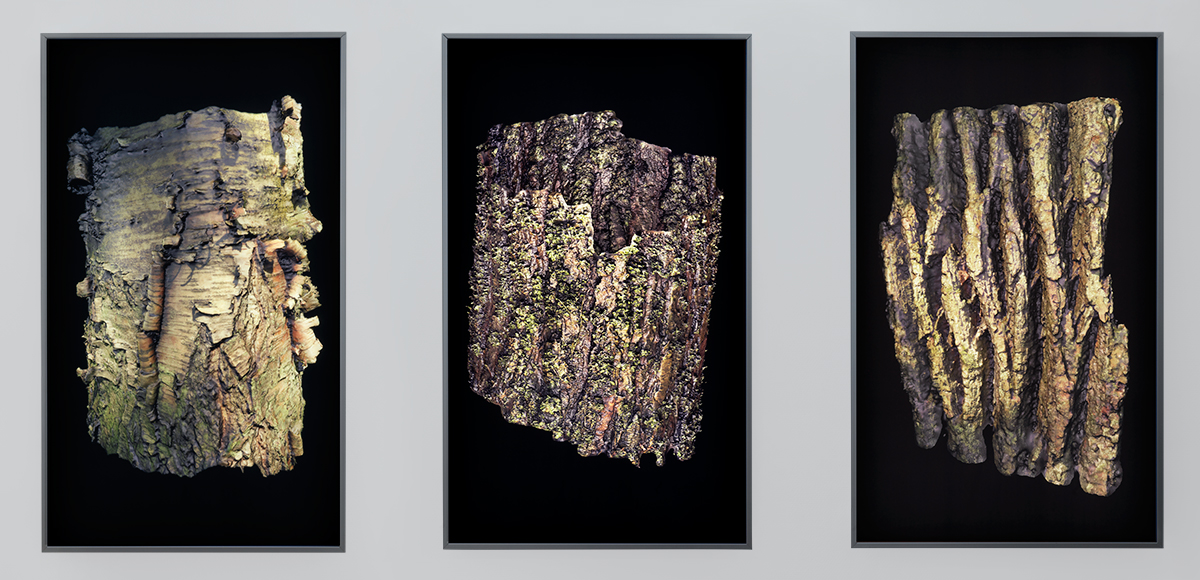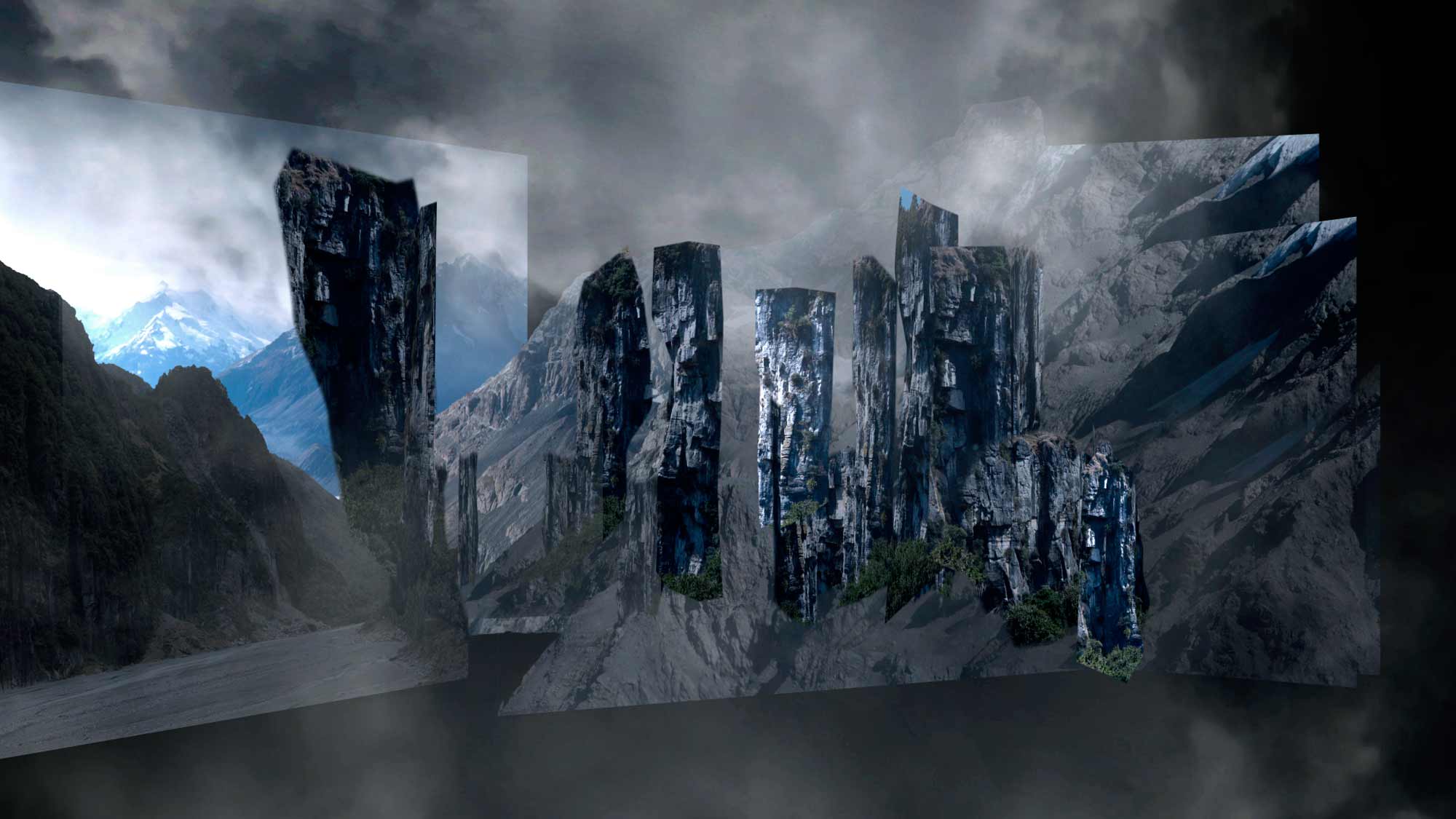The works of Persijn Broersen and Margit Lukács explore the infinitely malleable ultra-thin surface of digital photography in order to contemplate its role in shaping our experience and memory. In the present moment it is a medium characterised by a fast technological development and produces images pervasively present on screens in almost every aspect of life. The digital photographic image is associated with a set of operations, which have an affinity with forensic and military technology more than ever before.1 It is not an image to contemplate, but an image to touch and interact with, "a passage or a portal, an interface or part of a sequential process—in short, as a cue for action."2 While photography with its history as an analogue medium is at the heart of the concepts of document or evidence as an indexical record, in its current state digital photography is a medium that goes one step further than the documentary function. The photographic still is no longer a separate frame, but it becomes a cartographic surface that creates immersive environments and entire worlds. The new photographic image acquires a very intimate relationship to memory, with an interesting, but illusory promise for a total, perfect capture of objects, which are rendered as ultra-thin shells. Sometimes it is used to capture historical buildings and objects, render them as three-dimensional models and situate them in an environment. The photograph consumes the objects it captures and renders them available for use in an endlessly malleable spectacle. Arguably, the object itself, precisely because of its translation into a metamorphic object, is different from other types of images; it loses its rigid outline, and in a sense, its definition, it becomes a ruin. Using the figure of the digital ruin Broersen and Lukács contemplate, with a degree of melancholic sentiment, the future of our experience of saturated image-environments and of shaping, or in fact even constructing, our perceptions.

All or Nothing at All
All or Nothing at All (2019) borrows its title from the famous song performed by Frank Sinatra and composed by Arthur Altman in 1939. It is an eight-minute digital animation based on photogrammetry and assembles together multiplicity of photographs of the medieval town of Viborg, Denmark. The historic site is rendered as a hovering world reminiscent of a film set or virtual reality gaming world. Everything floats in water with its surface doubled into the liquid surfaces of the streets and the buildings, which appear as soft, liquid and fragmentary.
The soundtrack is based on an interpretation of the Sinatra song by a young singer Nina Vadshølt, whose voice is multiplied and rendered as a choir. She was cloned in multiple animated avatars of herself, who dance a choreography based on the musical Westside Story (1961). A dancer (Daniel Cilea) performed the dance and her moves were motion-captured and then grafted onto the avatarsinger. The town of Viborg becomes a strange décor for a musical with a dance sequence reminiscent of a fight game between two adversary groups, both composed of the multiple clones of a single character.
All or Nothing at All transforms Viborg into a world made of liquid surfaces, which flow and undulate. This ultra-thin liquid surface becomes a critical image, which invites us to reflect on the redefinition of the material, indexical trace associated with analogue photography into a new type of malleable surface that does not retain traces or marks. Still, the new image surface is prone to a different type of erosion, not as a constellation of marks that form a patina, but as digital erosion, which dissolves the materiality of objects and the outlines of their identity. This can be said to be an entropic moment, the loss of form into an endless plasticity.3
But unlike the seamless illusion of deep fakes, the digital surfaces in All or Nothing at All makes visible, and almost in a violent way, the operations that underlie it: twisting, fragmentation, erosion, and liquefying.
There is a melancholic warning in this. Like a digital vanitas of sorts, the work warns of the transience of memory, or of the dissolution of the experience of the past, of historical experience, which always needs, or at least so far, a material object, a trace, a photograph that will carry memory. The melancholic tune from the end of the thirties is there as a memory object. But simultaneously it is rendered as split, cloned, uncanny echo of the past stuck in a loop of a nightmarish perpetual present, a present without a past, or future, a present in which memories become flattened by their repetition and lose their emotional texture.
The sentimentality of the song is used a critical device, it is an anachronistic moment in conjunction with the liquid surface of the gamified décor of the medieval town populated by an army of clones. A wink to the past, when sentiments, emotions were somehow real, they were our own experience.
And now we are made to "desire by numbers" as Fyodor Dostoevsky a century and a half ago eloquently put that in his Notes From the Underground.4 If images can be said to bind with our psychological world and processes and to carry our memory, desire, sadness and enjoyment, conflicts, like a skin of emotional texture that layers over images, the images of All or Nothing at All, so torn, fragmented and liquefied, speak back to us of fragmentation of experience. Now we are offered the immersive experience of virtual digital worlds, but we still need images to contemplate in our own time and not images to drawn into.
The work, however, frustrates the immersive experience and invites us to reflect on the desire for immersion. The ultra-thin image becomes a strange nightmarish texture and a figure of the digital erosion of everything – feelings, images, objects, and ultimately history, which is stuck in an amplified loop in a present that endlessly clones itself onto itself. The liquid, almost psychedelic, image is no longer restricted to an individual experience of taking a psychedelic substance, but now proliferates on screens, which are everywhere. It becomes the new normal, a collective, and normalized hallucination of sorts, one of which Guy Debord could have only dreamt of when he was warning about the transformation experience into a total spectacle.5 Image streams today form the bubble we were discussing when the term “post-truth” was coined with the crisis of democracy we experienced relatively recently. There is no more in-between, but only polarities, subjective expectations which confirm themselves preserved as absorptive worlds.
For Forest on Location (2018) the artists collected an extensive photographic material at the site Europe’s last primeval forest - the Białowieża forest in Poland. It is a video installation that places its viewer into the soft, green darkness of a forest inhabited by a single protagonist (the avatar of the Iranian opera singer Shahram Yazdani) who walks, sings, and floats through the ground (or rather grounds), which becomes a liquid and permeable surface and at moments dissolves into a generic digital void devoid of gravity or direction. The fairy tale forest scene morphs into a virtual world resonating with film set under construction composed of freely floating fragments.
The scene is a meta-image, which lures its viewer to step in, float effortlessly with the melancholic tune and experience a gently settling nightmarish awareness that everything in this world is a liquid image-surface with no stable ground. Forest on Location is based on digitally assembling a multitude of photographic images taken on the site of the Białowieża forest into 3D models of tree trunks and the forest floor. Their surface is interrupted by a set of traces intentionally left there, and the images at moments spilling into only outlines, reveal their medium as a digital surface that is infinitely malleable, a meta-image pointing the operations of its own medium. Still, Forest of Location maintains a degree of documentary weight, which is related to the claim of the photographic image to be true to the reality of its object, to capture its material presence, to freeze it in time. Next to being at the heart of the concepts of evidence or document, concepts that are intimately related to our understanding and reconstruction of the past, photography is medium with an extraordinary plasticity, and with its own history, which now changes very fast. We photograph more and more, the images shared on screens, permeate and in fact define our experience, our self-images and memory.
The digital surface of photographs is no longer an image to contemplate or to look at. It replaces the hard outlines of objects and is endowed with a different potentiality; no longer a still that registers a moment in the past, but a surface that folds the past into a malleable present, in which the image becomes a tactile surface, which invites to zoom and scroll, edit, layer, share.
The choice of a tree trunk as a visual protagonist in Schweig mayn Harts (Hush My Heart) (2018) is strategic and poses a question with regards to photography as a precision medium, which allows access to the (in-)visible texture of the world. The irregular outline of the trunk, the surface of the bark covered with moss and fungi is an infinitely complex object and its rendering as a 3D surface print is based on taking multiple photographs and morphing them together. But precisely here at the threshold of the next level, of the possibility of reproduction of an object in its volume and materiality, photography confronts a loss.
The visual surface with its colour, and finer detail is impossible to 3D print and is layered over the model as a projection. The bodies of natural objects are still irreproducible and simulation remains dissimulation.

Phantom Bark at FOAM
The image as a layered surface is explored further in a series of three light boxes Phantom Bark_Birch_, Phantom Bark_Spruce_, Phantom Bark_Ash_, 2018, which present bark surface with a complex network of details. The uncannily real surfaces are in fact composed of multiple overlaid photographs. The edges of details come across not as sharp, but as deep and invite us to stay with the image and look, and then to look further. They suggest an interactive surface and invite to touch, to zoom, to sink in the flesh of the image.
Cast and Mould (2018) consists of two screens facing each other showing bark surfaces suspended in a continuous rotating loop. The title of the work refers to imprints, or images generated through contact with the objects they represent. Making an imprint is one of the oldest techniques of image-making, which is also at the heart of the photographic image. The two bark surfaces appear as an exact match, but not exactly as positive and negative. They are the face and the back of a digital surface. This proposes a different understanding of the photographic trace as a modulation of the same surface, which is a ultrathin membrane observable from both sides.

Establishing Eden
Establishing Eden (2016) is a video installation, which presents a breath-taking landscape rendered in a camera movement specific to the establishing shot in blockbuster films. The image reveals itself as an architectonic construction built of dramatic landscape surfaces, which split in layers, rotate, dissolve. An endless opening shot as a loop folding onto itself in an ever-lasting present, in which everything boils down to a surface. Double Mirror (2017) takes this question one level further by building a strange world inhabited by floating objects that modulate, morph and fold; a world with a texture that perhaps composes dreams and psychedelic experiences. The two works’ invitation is to reflect on our desire for immersive experiences of saturated visual environments, their affective impact and their blinding, liquid allure.
Broersen and Lukács employ the potential (and the histories) of media as film, sculpture, photography, landscape painting, animation to address a set of questions with a particular urgency in the present moment, in which we talk about post-truth. They use the discreet charm of traces and unfinished digital surfaces as details that speak of the urgency to look at the ways of looking.
July 2019, Amsterdam, Alena Alexandrova
1 Thomas Elsaesser argues that: […] the technologies of imaging today are not means of assisting
sight, whether of real or imagined things, but technologies of probing and penetration. As vision
machines, they generate knowledge that has little to do with human perception or seeing, in the
sense of ‘I see’ meaning ‘I know,’ and more to do with controlling territory, occupying space,
monitoring a situation, and mining it for useful information or active intervention.
The “Return” of 3-D: On Some of the Logics and Genealogies of the Image in the Twenty-First Century, Critical Inquiry: Winter, 2013, 242
2 Ibid., 241
3 Yve-Alain Bois and Rosalind Krauss argue for a broader interpretation of entropy as an artistic operation and concept in their Formless: A User’s Guide (New York: Zone Books, 2000), 38:
“In the hands of these artists entropy operates in various ways […] by degradation, by redundancy, by inversion, by wear and tear, by lack of elasticity […]” One could add to this list, as related to the new type of digital images, the loss of the rigid outline of objects into endless plasticity.
4 As it happens, if they do in fact discover one day a formula for all our desires and caprices – that is what they depend on, exactly from what laws they originate, exactly how they are disseminated, to what they are aspiring in one case or the other, and so on and so on, that’s to say a real mathematical formula, then man will very likely at once stop desiring anything and most probably cease to exist altogether. What is the point of desiring by numbers?
Fyodor Dostoevsky, Notes from the Underground, Translated by Ronald Wilks (London: Penguin Books, 2009), 24.
5 Guy Debord, The Society of the Spectacle, Translated by Donald Nicholson-Smith (New York: Zone Books, 1995).
The “Return” of 3-D: On Some of the Logics and Genealogies of the Image in the Twenty-First Century, Critical Inquiry: Winter, 2013, 242
2 Ibid., 241
3 Yve-Alain Bois and Rosalind Krauss argue for a broader interpretation of entropy as an artistic operation and concept in their Formless: A User’s Guide (New York: Zone Books, 2000), 38:
“In the hands of these artists entropy operates in various ways […] by degradation, by redundancy, by inversion, by wear and tear, by lack of elasticity […]” One could add to this list, as related to the new type of digital images, the loss of the rigid outline of objects into endless plasticity.
4 As it happens, if they do in fact discover one day a formula for all our desires and caprices – that is what they depend on, exactly from what laws they originate, exactly how they are disseminated, to what they are aspiring in one case or the other, and so on and so on, that’s to say a real mathematical formula, then man will very likely at once stop desiring anything and most probably cease to exist altogether. What is the point of desiring by numbers?
Fyodor Dostoevsky, Notes from the Underground, Translated by Ronald Wilks (London: Penguin Books, 2009), 24.
5 Guy Debord, The Society of the Spectacle, Translated by Donald Nicholson-Smith (New York: Zone Books, 1995).
Alena Alexandrova is a cultural theorist and an independent curator based in Amsterdam. She teaches at the Fine Arts and the Photography department at the Gerrit Rietveld Academy. Currently she is writing a book titled Anarchic Infrastructures: Re-Casting the Archive, Displacing Chronologies. She is the author of Breaking Resemblance: The Role of Religious Motifs in Contemporary Art (Fordham University Press, 2017) and regularly contributes to art publications and catalogues. Alexandrova curated a sequence of exhibitions exploring the conceptual figure of “anarcheology” in the practices of present-day artists. She holds a doctoral degree from the University of Amsterdam.
alenaalexandrova.com
Article in Metropolis


